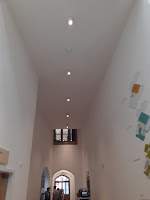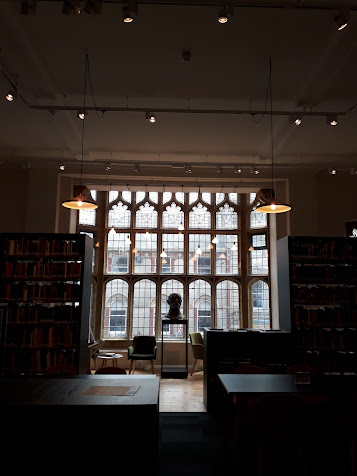
" The building and it's spaces evoked an autonomous feeling with a practical, flexible, and thoughtful approach to design, resulting in a catalyst to freely explore the museum and it's intended function for a memorable visitor experience "
THE SPACE
My initial response to the museum embedded the importance of how effective design and architecture is used to create a space that evokes a "Less is More" approach.
 |
| Looking towards the entrance |
 |
The use of both natural and artificial lighting has been combined to offer balance and a sense of freedom in which to explore the museum.
The spaces were inviting, with consistent flow that guided the visitor on an uninterrupted and memorable journey of exploration and discovery.
INTERACTIVE ELEMENTS
The types of interactive displays were varied, tactile, playful, fun, educational, and visually appealing. They were aimed at a cross section of visitors, accessible for all, and were not age restricted. I particularly enjoyed "Impress Yourself", and the period costume area.
The period costume area had a selection of historic attire with a changeable curtain backdrop for photo opportunities - this was fun!
The postcard display area was an opportunity to write a message and post it in the postbox provided.
Send a postcard |
Collaborative artwork - Impress Yourself |
THE LIBRARY
I was greeted with a view of an elaborate window with natural light flooding into the space, and acting as a theatrical backdrop for a sculpture by Elisabeth Frink.
An impressive, inviting, and relaxing space, with the distinct aroma of aging paper and old books, juxtaposed with the contemporary and modern approach to displays, fixtures, and fittings.
OTHER DISPLAY OBSERVATIONS

These include effective use of mirrors to view objects from different angles, video boxes provided a rolling visual history, and images were projected onto different mediums such as perspex, fabric, metal, wood, and paper, to add context to specific areas of historic reference.
Simple and effective use of wall space was optimised to display timelines and descriptive references.
 |
| Clear descriptions with key points |
  |
| Simple timelines |
 |
View of the art gallery |
 |
Connecting exhibits on display |
 |
| Discussing where to go next and what time is lunch! |
MUSEUM VISIT SUMMARY
Visited Dorchester museum, to explore, observe, and research the recent refurbishment, and how the space has been reimagined to optimise the space for the ultimate visitor experience.
My first impressions were positive and visually appealing. The building reflected it's function from the outside, and upon entering, the space opened up with a clean and contemporary approach to architectural design.
This evoked a feeling of how; a "less is more" approach to design and architecture is successful when form meets function. An inviting and encouraging start, inspiring me to begin my journey of exploring the museum and it's spaces.
Navigating around the museum was clear and uninterrupted, that was achieved by the use of simple and concise signage and directional plans, all located and positioned conveniently, with easy to read graphical instructions.
There was an effective combination of natural and artificial lighting providing a balanced environment, and allowing for adjustments when required. This was achieved by utilising the building's fabric to allow natural light to enter, and artificial lighting designed to guide visitors through the museum, and highlighting the exhibits, displays, and dedicated spaces.
The interactive displays were effective, fun, educational, playful, accessible for all, and not age restricted. Visual displays such as video boxes, illustrative graphics, and projected images onto various materials like, metal, wood, perspex, glass, and fabric were used effectively.
Exhibit details and descriptions were simple, clear, easy to read, and highlighting only the key points, and positioned to be accessible to all visitors.
This visit has inspired me to focus on a specific object, and has demonstrated how I intend to display and reference this by taking a simple approach.













Comments
Post a Comment